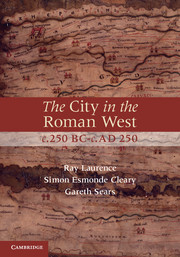Book contents
- Frontmatter
- Contents
- Illustrations
- Preface
- Introduction
- 1 The creation of an urban culture
- 2 Colonisation and the development of Roman urbanism
- 3 City foundation, government and urbanism
- 4 The reception of Roman urbanism in the West
- 5 Town planning, competition and the aesthetics of urbanism
- 6 Defining a new town: walls, streets and temples
- 7 Assembling the city 1: forum and basilica
- 8 Assembling the city 2: baths and urban life
- 9 Assembling the city 3: theatres and sacred space
- 10 Assembling the city 4: amphitheatres
- 11 The Roman city in c. AD 250: an urban legacy of empire?
- Bibliography
- Index
7 - Assembling the city 1: forum and basilica
Published online by Cambridge University Press: 05 June 2012
- Frontmatter
- Contents
- Illustrations
- Preface
- Introduction
- 1 The creation of an urban culture
- 2 Colonisation and the development of Roman urbanism
- 3 City foundation, government and urbanism
- 4 The reception of Roman urbanism in the West
- 5 Town planning, competition and the aesthetics of urbanism
- 6 Defining a new town: walls, streets and temples
- 7 Assembling the city 1: forum and basilica
- 8 Assembling the city 2: baths and urban life
- 9 Assembling the city 3: theatres and sacred space
- 10 Assembling the city 4: amphitheatres
- 11 The Roman city in c. AD 250: an urban legacy of empire?
- Bibliography
- Index
Summary
The forum in texts
By the time Vitruvius came to write De architectura (On Architecture) in the early first century AD, the forum had become a central feature of every city in both Italy and Greece. He explains the difference in form within these two distinct urban cultures: in Greek cities the forum was square with double colonnades, whereas in Italian cities it was rectangular because it was in this space that spectacula and gladiatorial games were held according to ancestral custom. The size of this rectangular space would have varied according to the size of the population, so that at the games the space did not appear half-empty or too crowded. Earlier examples from Italy demonstrate some variation – Alba Fucens: 142×44 metres; Cosa: 90×30 metres – and do not conform to Vitruvius’ suggested 3:2 proportion of length:breadth. The forum, as Vitruvius shows in his text, was very much a place of negotium, or business, with provision for tabernae (shops/offices) to be let out to the argentarii (money changers/bankers) and the positioning of an adjacent basilica in a warm location for use by negotiatores (traders) during winter. Another series of buildings adjacent to the forum were those of local government: the treasury, the curia and the prison. Vitruvius’ text concerns the meaning or use of a forum – as a place for traders and negotium, but also as a place for government. He makes no mention of a temple dominating the central piazza of the forum, and indeed the association need not have been central to the urban form that we understand as a space surrounded by public buildings. None of the early fora constructed in Latin colonies had a temple dominating the space, as can be seen at Paestum, Cosa and Alba Fucens. Instead, what was included at these sites conformed to the emphases already highlighted – a basilica for trade and a curia or Senate house for government. The latter, for Vitruvius, should have reflected the dignitas of the municipium or civitas and its acoustics should have enabled the assembled parties to hear the discussion within its interior. The whole forum was a place for public and private business controlled by the magistrates of the city.
- Type
- Chapter
- Information
- The City in the Roman West, c.250 BC–c.AD 250 , pp. 170 - 202Publisher: Cambridge University PressPrint publication year: 2011



